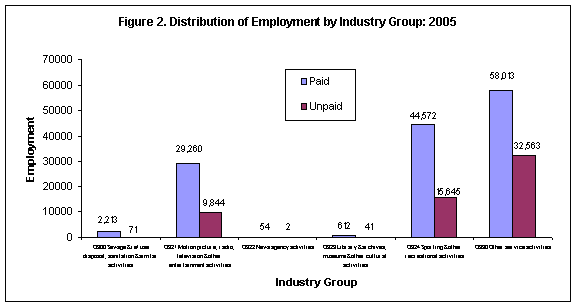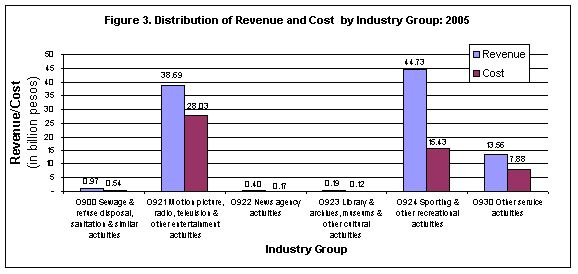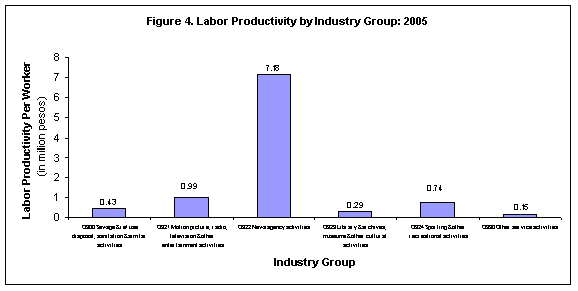Establishments with an average total employment of less than 20 dominate the sector
· A total of 45,817 establishments were covered in 2005 Annual Survey of Philippine Business and Industry (ASPBI) for other community, social and personal service sector. Of the total figure, 98.2 percent or 44,986 establishments had an average total employment (ATE) of less than 20 while the remaining 1.8 percent or 831 establishments had ATE of 20 or more. (See Tables 1 to 3.)
· Establishments involved in other service activities (PSIC O930) like dry cleaning, hair dressing and funeral parlor recorded the biggest number of establishments accounting to 30,387 or 66.3 percent of the total. Sporting and other recreational activities (PSIC O924) ranked second with 9,764 (21.3%) while motion picture, radio, television and other entertainment (PSIC O921) followed with 5,500 establishments (12.0%). Figure 1 shows the distribution of other community, social and personal service establishments by industry group.

Other service activities provide the largest employment
· Total employment generated in 2005 by other community, social and personal service sector reached 192,889 workers. Of this 134,724 or 69.8 percent were paid employees while the rest were working owners and unpaid workers. Distribution of employment by industry group is shown in Figure 2.
Establishments engaged in other service activities like dry cleaning, hairdressing and funeral employed the most number of workers with 90,573 or 47.0 percent of the total. Sporting and other recreational establishments ranked second with 60,218 workers (31.2%). This was followed by motion picture, radio, television and other entertainment establishments with 39,105 workers (20.3%).

Workers in news agency activities receive the highest average monthly compensation
· In 2005, the sector paid a total compensation of Php14.5 billion, equivalent to an average monthly pay of Php8,991 per paid employee.
· News agency employees received the highest average monthly pay of Php80,858 while employees engaged in other service activities like dry cleaning, hairdressing and funeral received the lowest monthly pay of Php4,761. See Table A for the average monthly compensation per paid employee by industry group.
Table A. Average Monthly Compensation Per Paid Employee By Industry Group: 2005
PSIC | Industry | Average MonthlyCompensation Per Paid Employee |
O | Other Community, Social and Personal Service Activities | Php8,991 |
O900 | Sewage & Refuse Disposal, Sanitation & Similar Activities | Php6,577 |
O921 | Motion Picture, Radio, Television and Other Entertainment Activities | Php15,145 |
O922 | News Agency Activities | Php80,858 |
O923 | Library & Archives, Museums and Other Cultural Activities | Php9,868 |
O924 | Sporting & Other Recreational Activities | Php10,478 |
O930 | Other Service Activities | Php4,761 |
Sporting and other recreational activities are top earners
· Total revenue earned by the sector in 2005 amounted to Php98.5 billion. Among the industry groups, sporting and other recreational establishments generated the highest revenue amounting to Php44.7 billion or 45.4 percent of the total revenue while library and archives, museums and other cultural activities contributed only Php187 million or 0.2 percent. Figure 3 illustrates the distribution of revenue and cost by industry group.

Motion picture, radio, television and other entertainment establishments incur the highest cost
· Excluding compensation paid to employees in 2005, the total cost spent by the sector reached Php52.2 billion. Motion picture, radio, television and other entertainment establishments incurred the highest cost amounting to Php28.0 billion or (53.7%) of the total. Sporting and other recreational establishments ranked second with Php15.4 billion (29.6%). Library and archives, museums and other cultural activities spent the least with Php120.5 million (0.2%).
Gross additions to fixed assets reach Php3.2 billion
· Gross additions to fixed assets of other community, social and personal service establishments reached Php3.2 billion. Motion picture, radio, television and other entertainment establishments recorded the highest with Php2.0 billion (64.2%).
Total change in inventories amounts to Php351.4 million
· Change in inventories in 2005 reported by the sector amounted to Php351.4 million. The highest change in inventories was reported by motion picture, radio, television and other entertainment establishments which comprised Php250.1 million or 71.2 percent of the total.
Subsidies total to Php227.1 million
· The government provided Php227 million as subsidies to the sector during the year 2005. Motion picture, radio, television and other entertainment activities received the highest subsidy with Php148 million or 65.2 percent of the total.
Labor productivity per worker is Php0.51 million
· Revenue per worker, a measure of labor productivity was valued at Php0.51 million. The highest labor productivity at Php7.18 million was attained by news agencies. On the other hand the lowest labor productivity at Php0.15 million was exhibited by establishments engaged in other service activities. Figure 4 displays labor productivity by industry group. (See also Tables R1 to R3 for other economic indicators.)

TECHNICAL NOTES
Scope and Coverage
The 2005 Annual Survey of Philippine Business and Industry (ASPBI) was conducted to collect information on the structure and trends of economic activities in the entire country for the year 2005. Covered were establishments engaged in economic activities as defined under the 1994 Philippine Standard Industrial Classification (PSIC). These establishments were classified into 14 sectors, one of which is on Other Community, Social and Personal Service Establishments (Sector O). The sector is composed of establishments engaged in sewage & refuse disposal, sanitaion and similar activities (O900), motion picture, radio, television and other entertainment activities (O921), news agency activities (O922), library & archives, museums and other cultural activities (O923), sporting & other recreational activities (O924), and other service activities (O930).
All other community, social and personal services establishments nationwide with average total employment (ATE) of 100 and over were covered on a 100 percent basis and those with ATE less than 100 were selected using simple random sampling.
Response Rate
A total of 1,041 or 99.62% responded out of the 1,045 samples drawn for the sector but the effective response rate is 65.93% only.
Concepts and Definition of Terms
Establishment is an economic unit, which engages under a single ownership or control, i.e. under a single legal entity, in one, or predominantly one kind of economic activity at a single fixed location.
Economic activity or businessor business is the activity of the establishment as classified under the1994 Philippine Standard Industrial Classification (PSIC). The main activity refers to the activity that contributes the biggest or major portion of the gross income or revenue of the establishment.
Total Employment is the number of persons who worked in or for the establishment as of November 15, 2005.
Paid employees are all persons working in the establishments receiving pay as well as those working away from the establishment when paid by and under the control of the establishment. Included are persons working as full-time or part-time and those employees on sick leave, paid vacation or holiday. Excluded are consultants, home workers and workers receiving commission only.
Unpaid workers include working owners who do not receive regular pay, apprentices and learners without regular pay, and persons working without regular pay for at least one third of the working time normal to the establishment.
Salaries and wages are payments in cash or in kind, prior to deduction for employee's contribution to SSS/GSIS, withholding tax, etc. Included are total basic pay, vacation, sick, maternity leave pay, overtime pay, and other benefits.
Revenue refers to cash received and receivables for goods sold and services rendered.
Cost refers to all expenses excluding compensation incurred during the year whether paid or payable. Valuation should be at market price including taxes and other charges, net of discounts, rebates, returns and allowances. Goods received from and services rendered by other establishment of the same enterprise are valued as though purchased.
Gross additions to fixed assets refer to the cost of acquisition of fixed assets acquired in 2005 less the value of sales of fixed assets during the year.
Fixed assets are physical assets expected to have productive life of more than one year and intended for use and/or being used by the establishment. Included are land, buildings, fixtures, machinery, tool, furniture, office equipment, vehicles, and the like.
Capital expenditures refer to the cost of acquisition of fixed assets acquired in 2005 whether or not full payments have been made.
Subsidies are special grants in the form of financial assistance or tax exemption or tax privilege given by the government to develop an industry or production and to protect it against competition.
Inventories refer to stocks of goods owned by or under the control of the establishment as of a fixed date, regardless of where the stocks are located. Valuation should be at current replacement cost in purchaser's price at the indicated dates. Replacement cost is the cost of an item in terms of its present price rather than its original price.
Change in Inventories as a derived indicator is computed as the value of ending inventory less the value of beginning inventory.
Value Added is the total revenue plus capital expenditures (own account) plus change in inventories less total cost (net of indirect taxes, interest, bad and doubtful debts and depreciation).
Source; National Statistics Office
Manila, Philippines
